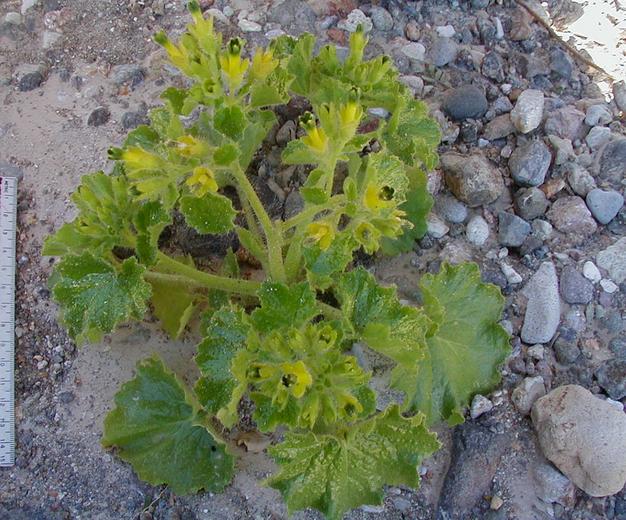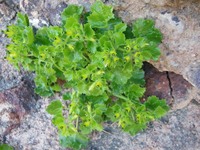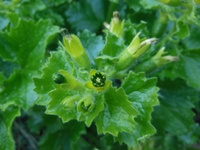|
|
|
|
Family: Loasaceae
rock nettle
[Sympetaleia rupestris (Baill.) Gray ex S. Wats.] |
Plant: Suffrutescent perennial herb; hairs barbed, some stinging; STEMS 1-several, 4-35 cm long Leaves: ovate to suborbicular; petiole 1-6 cm long; blade 1.5-7 cm long, 1.5-8 cm wide; margin short-toothed, usually lobed; uppermost leaves short-petiolate INFLORESCENCE: cymose Flowers: inconspicuous; calyx lobes oblong, 0.8-1 cm long; corolla sympetalous, tubular, 9-18 mm long, the tube 6-14 mm long, yellowish, the lobes 3-4 mm long, green, erect; stamens epipetalous, included; filaments to 2 mm long; style included, not exceeding stamens Fruit: capsules reflexed, to 1 cm long excluding calyx lobes; SEEDS numerous, 0.5-1.5 mm long, parietal; testa longitudinally striate; endosperm lacking Misc: in crevices of rock faces or on very steep rocky slopes; 350-500 m (1100-1500 ft); Dec-Feb REFERENCES: Christy, Charlotte M. 1998. Loasaceae. J. Ariz. - Nev. Acad. Sci. 30(2): 96. Christy 1998, Jepson 2012 Duration: Annual Nativity: Native Lifeform: Forb/Herb General: Herbaceous or suffrutescent annuals to perennials, to 35 cm tall, stems 1-several, herbage covered with stinging, barbed hairs. Leaves: Alternate, ovate to suborbicular, 1.5-7 cm long, 1.5-8 cm wide, with short-toothed or round-lobed margins, petioles to 6 cm long, the uppermost leaves short-petiolate, surfaces dark green above, lighter green below (or not), dotted with stinging hairs. Flowers: Inconspicuous, yellow or yellow with green tips, corollas tubular with 5 green, acute-tipped, erect lobes 3-4 mm long, corollas 9-18 mm long, the tube 6-14 mm long, yellowish, sepals 5, persistent, calyx lobes oblong, 0.8-1 cm long, stamens many, included and attached to the petals (epipetalous), filaments to 2 mm long, stigmas with 5 lobes, styles included and not exceeding the stamens, ovaries inferior, flowers borne in cymose infloresences. Fruits: Cylindric, reflexed capsules 7-15mm long, dehiscent at the top by 5 valves, pedicles to 2 cm long. Seeds oblong, numerous, 0.5-1.5 mm long, with grooved or ribbed surfaces. Ecology: Found in crevices of rock faces or on cliffs or very steep, rocky slopes, from 1,000-2,000 ft (305-610 m); flowering December-April. Distribution: Arizona, California. Notes: At first glance, this species looks like a mallow with its ovate to suborbicular leaves with few-toothed, lobed margins, but the stinging hairs of the leaves and stems give it away. Look for this species in Arizona in Yuma county. Not treated in older versions of Kearney and Peebles. Ethnobotany: Unknown. Synonyms: None Editor: LCrumbacher2012 Etymology: Eucnide comes from the Greek eu, "good or pretty," and knide, "stinging nettle," thus being a strongly nettle-like plant, and rupestris means growing among rocks. |





